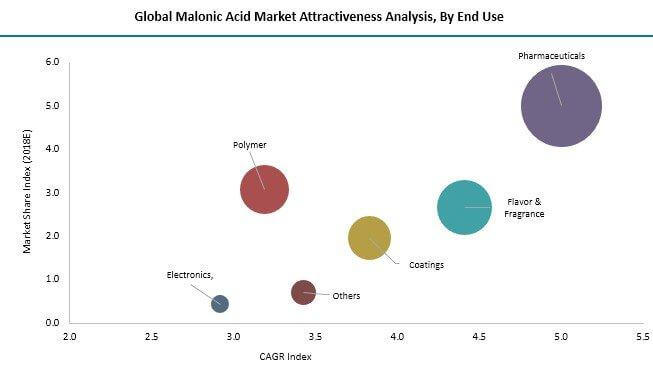Market Outlook
Over the recent past, demand for malonic acid and its ester compounds has increased in several end use industries, such as pharmaceutical, coating, electronics and polymer & plastic, among others, owing to its multifunctional nature and characteristic properties. Due to the multi-functional nature of malonic acid, it can be used as a precursor, active pharmaceutical ingredient (API), cross linker, additive and intermediate compound, among others.
Download sample copy of this report:
https://www.futuremarketinsights.com/reports/sample/REP-GB-6550
Malonic acid, formula CH2(COOH)2, is also known as propanedioic acid. It is a white crystalline dicarboxylic acid compound that is readily soluble in alcohol & ethers. Through ionization of malonic acid, malonic esters are produced, which are called as malonates. Historically, the first synthesis of malonic acid was carried out through oxidation-reduction of malic acid with potassium dichromate. With industrial developments and advancements in manufacturing technology, several methods for the production of malonic acid were developed and commercialized. Moreover, commercially, malonic acid is produced from chloroacetic acid and diethyl malonate.
As an intermediate, malonic acid is used in the manufacturing of alkyd resins, which are further used in coating applications to prevent damage caused due to oxidation, UV light and corrosion. Also, malonic acid is used as a cross linker in low-temperature cure powder coatings to accelerate the coating process. Moreover, malonic acid is also used to induce cross-linking in starch compounds, which are further used in the manufacturing of biodegradable thermoplastics. Furthermore, as a building block, malonic acid is used in the production of pharmaceutical compounds, specialty polyesters, flavor and fragrance compounds and electrolyte additives, among others.
Global Malonic Acid Market: Segmentation
The global Malonic Acid market can be segmented on the basis of grade, function and end-use.
On the basis of grade, the global Malonic Acid market can be segmented as follows:
- Technical Grade
- Pharmaceutical Grade
On the basis of function, the global Malonic Acid market can be segmented as follows:
- Precursor
- API
- Additive
- Other
On the basis of end use, the global Malonic Acid market can be segmented as follows:
- Paint & Coating
- Polymer & Plastics
- Pharmaceutical
- Flavor & Fragrance
- Electronics
- Others
Upsurge in demand from pharmaceutical & Coating industry
Over the recent past, there has been significant growth in malonic acid consumption. This can mainly be attributed to growing demand from the pharmaceutical and coating industry. Rise in demand for malonic acid as an active pharmaceutical ingredient (API), supported by its increasing utilization for producing Diclazuril, non-steroidal anti-inflammatory agents and various vitamins, such as B1, B2, B6, among others, have been the key driving factors responsible for its growth. Moreover, macroeconomic growth of the pharmaceutical industry in developing countries, such as China, India, ASEAN and African countries, will be a prominent factor supporting its market growth.
Further, malonic acid finds usage as a crosslinking agent in low temperature powder coatings. With the paints & coatings industry shifting towards water-based and powder coating systems, from traditional solvent-borne coatings, the demand for malonic acid is expected to witness a healthy upsurge. These non-conventional paints and coatings significantly reduce the volatile organic compound (VOC) emissions, in turn, causing increased traction across various parts of the world.

Global Malonic Acid Market: Key Players
The malonic market is a highly fragmented market and a significant share of the market is accounted by the presence of small to the medium players. Some of the key players identified across the value chain of the global Malonic Acid market include Lonza Group, Trace Zero LLC., Wuhan Kemi-Works Chemical Co., Ltd., Hefei TNJ Chemical Industry Co.,Ltd., Shanghai Nanxiang Reagent Co., Ltd., TATEYAMA KASEI co.,Ltd, MedicalChem(Yancheng)Manuf.Co.,Ltd., Columbus Chemical Industries, Inc., J&K Scientific Ltd.,etc.
Buy Now to Get 10% Off and Free Customization as per Requirement:
https://www.futuremarketinsights.com/checkout/6550
Opportunities for Market Participants
Adoption of organic and inorganic growth strategy and increasing demand from end-use industries, such as polymer & plastic, coating and pharmaceutical industry, among others, will support demand in the global market. Regulations pertaining to the use of bio-based chemicals in Europe and the U.S. will support sustainable development because of which several players are emphasizing on the development of bio-routes for the production of malonic acid. A report published by the U.S. Department of Energy on Top 30 value-added chemicals that can be produced from biomass-derived sugar identified malonic acid as one of the prominent chemicals. Consequentially, several players are focusing on the development of bio-based routes for the manufacturing of malonic acid to comply with government regulations. In 2015, Lygos, Inc. had produced malonic acid from biomass-derived sugar, which turned out to be cost-effective and eco-friendly as compared to traditional petroleum routes